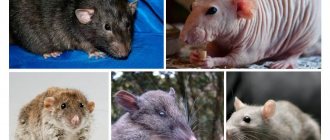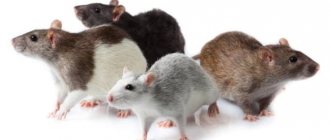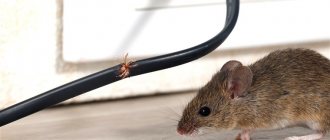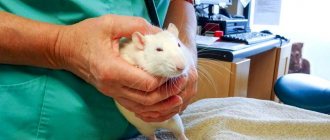Human attitudes towards rats are ambiguous. Some are afraid of them, citing the example of the Middle Ages, when the rat became the culprit of epidemics. Others hate them and try in every possible way to eradicate them. Others have not encountered them in life, so they are neutral towards them.
There is also a 4th category - people who keep this animal as a pet. It doesn't matter what category you fall into. Anyone can encounter this rodent, and the result of this encounter can be a rat bite. Then the question arises - what to do if bitten by a rat, what are the complications and consequences?
Rules for first aid for rat bites
Rats are the most widespread order of rodents on earth. Every year, about 15 thousand people worldwide suffer from the bites of these pests and approximately 100 of them die. This happens due to the fact that this small animal is a carrier of infectious diseases that are fatal to humans. Therefore, it is necessary in the first minutes to decide what to do if you become the target of a rat attack. In most cases, the penetration of microbes into the body depends on compliance with the basic rules of first aid.
What to do if rats bite children in kindergarten?
In many cases, rat bites require not only therapeutic but also administrative measures. Still, in accordance with sanitary standards, there should be no rats, mice, or any other rodents in the premises next to a person. And if in his home a person himself is responsible for preventing their occurrence, then in various educational institutions it is quite possible to demand compliance with these measures from the administration.
For example, if rats bite children in a kindergarten, there is a flagrant violation of sanitary standards. What should be done if the kindergarten administration did nothing in response to such an emergency?
- Compile and send an application to the regional SES office. The service usually responds promptly to complaints regarding municipal enterprises;
- Send an appeal to the deputy head of the city administration;
- If there is no response from the deputy head and the SES, write a complaint to Rospotrebnadzor.
It is very important that all complaints and appeals be collective, from at least three to four parents. This will help employees of the relevant services to distinguish the real problem from the far-fetched complaints of some scandalous mother.
It is advisable to attach to all requests copies of certificates from the clinic where the bitten children were examined by a doctor, as well as photographs and copies of letters to other authorities from which no response was received.
Rat bite
Rodents use their teeth when forced to defend themselves. The animals themselves are aggressive, but they rarely attack humans. Rodents that carry various diseases pose a danger. When bitten, the infection enters the bloodstream and spreads throughout the body. A rat bite is always a cause for concern. Animals are kept in unsanitary conditions and are often carriers of infections. The exception is domestic rats, but even from their bites a person can contract the disease.
How to stop a rat from biting?
It will take patience and desire. There are specimens that themselves do not like communication and want to be left alone. If an animal bites during play, or there is a hormonal surge, then all the miracles of diplomacy must be applied.
In the process of fighting for territory, the rat that puts its opponent on its back wins. If the pet tries to bite, you should put it on its back and hold it in this position for 20-40 seconds.
Working with a spray bottle is considered a safe way. If bitten, spray a little with water using a spray bottle. After 5-7 times the rodent will understand that it is not worth biting.
When the animal has grown up and got used to the owner, simply drive him away and not let him near, so that the rat understands that you are not inclined to communicate in such a way.
You shouldn’t hurt your pet, click him on the nose, pick him up by the tail, and especially not deprive him of food/water or take him out to the balcony in winter. Such methods are more likely to cause additional aggression, undermine health and will not lead to the desired result.
Carrying out deratization
Deratization is a set of procedures aimed at controlling rodents. They are exterminatory and preventive.
The goal of prevention is to prevent the appearance of rats in enterprises or premises. Typically, during prevention, the entry routes for animals and access to food are closed. It is also necessary to maintain the cleanliness of the premises, take out the garbage in a timely manner, and get rid of waste. You should not neglect the condition of waste accumulation areas and clean the area in a timely manner.
Brief description of rat species
Probably everyone knows what wild rats look like. Even if you have never met a rat in person, you know exactly what it looks like. All thanks to popular culture and cinema.
There are three species of rats in Russia and the CIS countries. All of them, one way or another, pose a danger to humans . And we are talking not only about dangerous diseases that a person can become infected with after a rat bite, but also about damage to agriculture, food supplies in the house and even furniture. The larger the colony of rats, the more trouble it can cause.
Gray rat (pasyuk)
The gray rat is the most common. And in size it is clearly larger than its counterparts. It is difficult to judge what size rats are. A well-fed rat with direct and constant access to a food source can gain up to 1-1.5 kg. But most gray rats do not weigh more than 0.3-0.5 kg.
What does a rat look like compared to mice?
The gray rodent has 16 teeth, 12 of which are molars, and 4 are impressively sized incisors. It is with the incisors that the rat bites.
Pasyuk is omnivorous . It hunts small mammals and skillfully and cruelly destroys bird nests. He also loves the succulent parts of various plants, young bark, all types of grains, any food in the house and, of course, your furniture. Sometimes it can hunt cats and dogs, especially in a pack . Swims great, dives great.
Interesting! Although the gray rat can climb, it prefers to walk on hard surfaces and find food there. But if the rodent is hungry, it will easily climb onto a high shelf or into a cabinet in the kitchen.
The animal is distinguished by its cruelty and impudence. It can attack a person, but only in cases where there is no other choice. There are known cases when a pack of rats attacked cattle and pigs.
Black wild rat
Photo of a black wild rat
Black rats differ from their gray counterparts in having a more moderate temperament, size and agility. They are not so aggressive and lead a hidden lifestyle . Adults rarely weigh more than 0.3 kg.
This rodent also likes to settle closer to humans and food. Loves warmth and usually does not dig holes. It settles in tree hollows, under the floor in a private house or apartment, making a nest, like a bird.
It does not reproduce as actively as the gray rat, so these two species never live next to each other. Moreover, gray rats often hunt their smaller black-colored brothers.
Can't swim and runs away at the first sign of danger. Does not attack dogs and cats. Black rats are extremely careful. They are not predators , preferring to feed on roots, grains, nuts and fresh shoots of various plants. They live in large flocks, where the leader rat is the main one.
Interesting fact! Previously, black rats lived in thatched roofs, which is why they were called roof rats.
Turkestan rat
Photo of Turkestan rat
The Turkestan rat is more like a house mouse. This is a cross between a black and gray rat. The size of an adult is no more than 0.3 kg. The character is not aggressive. On the contrary, at the slightest danger the rodent flees.
It prefers to live in the wild, but with the onset of cold weather, or when there is not enough food for life and reproduction, it comes closer to people. The Turkestan rat can be found both in a private house and in an apartment on the 9th floor .
The rat is especially troublesome for farmers and agricultural land. The rodent feeds on various grains, green shoots, young bark and nuts. Attempts to destroy the species are made annually, but this only temporarily restrains the growth of the colony.
Consequences of a bite
The human body is individual.
Therefore, the healing period will occur differently for everyone. The temperature may rise, inflammation may appear, and headaches may occur. The injury itself when bitten by rats is also dangerous. There were cases when people were bitten on their earlobes, nose wings, and fingers. Statistically, they bite hands, but this means that rodents mostly attack in self-defense. In developed countries, rat bites are less known than in backward ones. Due to the large accumulation of garbage and poor sanitary conditions, there are a lot of such rodents.
In addition, bites can lead to psychological consequences. People often begin to become terrified of these animals, living in fear that they will be able to climb out of pipes and toilets.
Differences between rat bites and bites of other animals
In some cases, it is not even clear who exactly bit the person - a rat, a mouse, or some other animal. For example, a bite can occur when a person is sleeping, or someone bites a child on the finger while he is playing in the house or on the street. It is even more difficult to identify the offender if the person who was bitten was a pet.
In general, it is not difficult to distinguish a rat bite from the bite of another animal. After a rodent attack, as a rule, two small bleeding wounds remain at the site of the bite - from the upper and lower incisors (sometimes such wounds are represented by two nearby skin lesions, since the rat has two well-developed upper and two lower incisors). This “pattern” is characteristic of rodent bites.
The photo below shows what a rat bite looks like on a person’s hand:
Perhaps the easiest way to confuse such a bite with the bites of other rat relatives: mice, voles, hamsters. The rat differs from them only in size (however, there is no need to make such a diagnosis, since all wild rodents are about as dangerous as rats).
What to do if you are bitten by a wild rat
The greatest danger to humans comes from the bite of a wild animal. Let's figure out what to do if you are attacked by a wild rat.
You absolutely need to see a doctor, and before that, start treating the wound yourself as quickly as possible. Wash the affected area generously and thoroughly with a solution of laundry soap after the bleeding has stopped. To prepare the solution, take 1/3 of a bar of soap and dilute it in two glasses of water. After this, it is necessary to disinfect the wound with any antiseptic and apply a bandage. This way you will protect yourself from infection.
You can learn how to humanely kill a parasite in this article.
A wild rat, unlike a domestic rat, lives on the street, climbs into garbage cans and landfills, so the likelihood of infection is very high.
The most dangerous pests are for a sleeping person. After all, the likelihood of infection increases due to bites in the neck and face due to the peculiarities of the circulatory system in these places. The vessels here are located close to the skin, so the infection immediately enters the blood. In this case (as in others), it is also necessary to see a specialist.
What symptoms indicate infection?
The incubation period for most diseases ranges from several days to a couple of weeks. Characteristic symptoms of infection:
- elevated temperature;
- chills;
- feeling of weakness;
- gastrointestinal disorders, namely vomiting, diarrhea, lack of appetite, abdominal pain;
- pain in the bite area, suppuration;
- uncontrolled muscle contractions;
- insomnia.
If you notice similar symptoms, consult your doctor for a diagnosis. It is important to tell the doctor when the bite occurred. This is the main difficulty: by the time they go to a medical facility, patients forget about the injury received from the rodent.
Wound healing and factors influencing this process
The wound healing process can be disrupted by many factors.
Healing is the process of repairing damaged tissue and restoring its integrity. During the healing process, certain processes occur. We will not dwell on them in more detail, but will only indicate those factors that may disrupt the healing process:
- Age. As a rule, this applies more to older people. The child's body has great regenerative capabilities. This is due to the high level of anabolic (construction) processes in the body.
- Attachment of infection.
- Decreased immunity.
- Poor circulation in the wound area.
- Chronic diseases (diseases of the respiratory and cardiovascular systems, diabetes, tumors and others).
Healing complications
- Attachment of infection . Most often, a nonspecific purulent infection develops. The threat is tetanus, rabies, diphtheria. Therefore, injuries that have been bitten and contaminated with soil or old metal objects should be immediately examined by a surgeon with a number of preventive measures taken (administration of anti-tetanus serum, rabies vaccine).
- Bleeding.
- Divergence of defect edges.
- In some cases, healing may be complicated by a hypertrophic scar or keloid . They are an abnormal scar that can spread beyond the defect area and also contribute to the development of complications.
Prevention and precautions
To prevent rat bites, you must take the following precautions:
- it is forbidden to touch rats (even dead ones brought by cats);
- Do not visit rodent habitats (basements, underground sewers, cellars, landfills, construction sites);
- Be careful near fields and ponds;
- You should not pet an aggressive pet rat. A rodent can be calmed by splashing cold water on the animal;
- a pet rat requires vaccination and regular veterinary examination;
- If you cannot avoid meeting a rat, you should not provoke it to attack (try to make contact, drive it into a corner, move sharply).
A rat bite is a serious reason to seek medical attention. But even a professional doctor will not be able to help a person if treatment is delayed. Therefore, you definitely need to know what to do when attacked by rodents and how to provide first aid.
A rat bitten until it bled: first aid
The wound is usually deep, very painful and has difficulty healing. In this case, the edges are quickly tightened, which prevents blood from escaping, which could have become infected.
Algorithm of actions:
- First of all, squeeze out as much blood as possible from the wound to eliminate the presence of dirt.
- Rinse under running water for at least 5 minutes.
- Then treat the bite site with any antiseptic: hydrogen peroxide, chlorhexidine, a weak solution of potassium permanganate.
- Apply iodine or brilliant green to the wound.
- If necessary, cover with adhesive tape.
- Monitor your health for a few days. And do all household chores with gloves.
Wound treatment is the same for adults and children.
It is of great importance that the pet is truly domestic, vaccinated and kept in good conditions.
If a rat bites a child, be sure to talk to the child and explain how to handle the pet. The bite could occur after the animal was squeezed too hard, hurt or scared. The main thing is to explain to the child that the rat must be handled carefully and then it will not cause trouble.
When to contact a medical facility
A person bitten by a wild rat must be taken to a medical facility if the following symptoms are observed a few days after the incident with a rodent attack:
- increased body temperature;
- headache;
- stool disorders (diarrhea);
- nausea;
- muscle pain;
- chills;
- enlarged liver and spleen;
- involuntary contraction of muscle tissue around the wound;
- general weakness and malaise.
Such signs indicate the development of a viral or bacterial fever and require immediate medical intervention. They can appear a few hours, 1-2 weeks, or even a month after the bite.
The greatest danger is the development of tetanus. In this case, the patient experiences acute pain at the site of the bite even several weeks after the animal’s attack, tension in the chewing muscles, making it impossible to open the mouth, pain in the back, and sleep disturbances. If the person who was bitten has not had a tetanus shot in a long time, he or she should go to the emergency room to receive tetanus serum.
How to Avoid a Rat Bite
To avoid the possibility of being bitten, the following recommendations should be followed:
- Avoid contact with wild rodents, being near landfills and sewers.
- If rats appear in your home, do not try to get rid of them yourself, but seek help from specialized services and leave the house for a while;
- When meeting a rodent, do not provoke its aggression by trying to catch, chase, photograph, etc.
If an animal shows menacing intentions, you can scare it away by sprinkling water.
If you want to get a decorative rat, you need to purchase a pet at a veterinary store. In this case, the seller must provide the buyer with medical certificates confirming that the rodent does not have any dangerous infectious diseases.
What is rabies?
Rabies (or rabies, from the Latin word rabies, hydrophobia, fear of water) is an acute infectious disease resulting from the bite of a dog or other infected animal, which is characterized by severe damage to the nervous system and usually ends in death.
The danger of rabies was known in ancient times, but there were no treatment methods, and every victim was doomed to death.
Only the great French scientist Louis Pasteur managed to create a vaccine against rabies (rabies vaccine) in 1885. On July 6, 1885, he saved the life of a 15-year-old teenager who was bitten by a rabid dog.
How does rabies become infected?
The causative agent of rabies is the Neuroiyctes rabid virus, which contains a single strand of RNA. The virus is resistant to freezing, antibiotics and phenol, drying, and direct sunlight. Destroyed by heat, acids and alkalis.
When a dog (or other animal) bites, infection occurs as a result of saliva from a rabid animal entering the wound. Once under the skin, the rabies virus quickly reaches the central and peripheral nervous systems. The rate of spread of the disease depends on the location of the wound (the higher the bite site, the faster the infection), the depth and size of the wound, and the reactogenicity of the human body (i.e., the susceptibility of the nervous system to a given pathogen).
1 Dog bite. First aid
2 Dog bite. First aid
3 Dog bite. First aid
Symptoms of rabies
The incubation period lasts from 1 to 3 months (sometimes from 12 days to a year). The speed of spread is influenced by the location of the bite.
There are 3 stages of the disease: initial (depression), stage of excitement, stage of paralysis.
Are bites from tame rodents dangerous?
Rodents purchased from a pet store are safe. Rats are carriers of diseases only if they are bitten by an infected animal. The possibility of getting sick is minimized, but still present.
If a decorative rat inflicts a superficial injury during a bite, just wash the wound with soap and treat it with brilliant green.
If an animal bites until it bleeds, the injured area may fester. To prevent infection, the wound is washed with soapy water and then treated with Rivanol.
Rats bite each other: what to do?
Between themselves, living in the same cage, animals can fight for territory, which is also evident from the bites on their fur. If animals cannot get along with each other, then it is better to place them in different cages. Sometimes it comes to living in different rooms and completely excluding communication with each other.
The reasons are the same instincts, which are not expressed weakly in all domestic animals; sometimes the call of the ancestors is strong and no punishment will help. Moreover, such competition between rodents does not exclude a good attitude towards the owner.
Keeping decorative rats imposes on the owner the responsibility of caring for and raising his pet. Compliance with basic hygiene rules, careful care of the animal, and selection of high-quality food will bring results. A kind, affectionate pet rat will not bite and will remain cheerful and healthy.
Great article 14
Causes
To maintain good, friendly relationships, you should avoid situations in which the rat might bite.
- The pet was hurt;
- Scared;
- Hungry animal;
- The desire to attract attention.
Bites without a reason in domestic rats are practically excluded. If you squeeze an animal for a long time, then when it gets tired, it can gnaw lightly, thereby saying “enough.”
After preparing or eating food, you should also wash your hands thoroughly so that the smell of your fingers is not confused with food.
A rat may also bite another pet, such as a cat or dog. The reasons are the same - protecting one’s territory, fear, approaching danger. It happens that pets get along nicely next to each other and even play.
Any wounds sustained by pet rats should be treated, regardless of whether the bite was a human or a pet.
With a strong bite, the wound may not heal for a long time, especially in an animal when there is fur nearby, which constantly irritates the “battle wound.” Bites are painful, but by providing comfortable conditions for all family members to stay in the house, they can be avoided.
What harm can rats cause to humans?
The only damage that rats can cause to humans is minor damage to the skin.
Sometimes they may bite a piece of skin or an earlobe.
In some cases, a broken finger may occur. When rodents attack people, they most often jump on their hands or face. It happened that a pack of hungry rats attacked sleeping residents of poor neighborhoods and chewed off their heels. Unfortunately, this phenomenon happens quite often in houses with unsanitary conditions. But the serious and key danger that rats pose is the infection they carry.
Possible diseases
According to statistics, every year 100 thousand people become victims of animals. The average number of deaths per year from a rat bite is 100 people. However, the risk of direct infection is reduced to almost zero if the bite site is properly treated. Exceptions are dangerous infectious diseases that are transmitted through blood and lymph.
Sodok
Sodok is a blood poisoning that can be cured at the initial stage. The wound itself is surgically cleaned, and an antibiotic injection is injected into the body. The risk of death from such a disease in the absence of treatment or in case of delayed assistance is 10 percent.
Listeriosis
Listeriosis is especially dangerous for people with weakened immune systems. This group includes pregnant women, older people and people with immune system diseases. If a pregnant woman gets listeriosis, she may lose her baby.
Coxiellosis
Coxiellosis is a bacterial infection. It is expressed in severe fever. It is almost not dangerous to life, but it can directly cause a lot of unpleasant consequences for the body.
Rabies
There is a popular myth that rats carry rabies. However, this statement is far from the truth. In the entire history of mankind, only a few people have contracted rabies from a rodent bite. In addition, you can save yourself from this disease with just 5 injections. If treatment is started late or not started at all, rabies can be fatal.
Tetanus
Tetanus is the most dangerous of infections. During it, a person develops direct damage to the nervous system and internal organs. This is often fraught with rapid death. Every year, about 50 thousand people die from tetanus. Often the victims of tetanus are children and adolescents.
Yersiniosis
Yersiniosis is characterized by vomiting, nausea, diarrhea, high fever and abdominal pain. In people with strong immunity, symptoms of the disease appear within a day after the bite, but in people with weak immunity, the disease can make itself felt only after as much as 30 days.
Toxoplasmosis
Toxoplasmosis is especially dangerous for pregnant women. It is transmitted to cats from rats they have eaten. Further, the cat can directly infect its owners with toxoplasmosis.
Cryptosporidiosis
Cryptosporidiosis affects people with weakened immune systems. Its main symptoms are abdominal pain, diarrhea and bloating.
Melioidosis
A person can be effectively cured of this disease only if they seek medical help in a timely manner. Melioidosis is characterized by fever, joint and muscle pain, and elevated temperature.
Injuries
In addition to infections, rats can cause considerable harm to humans in the form of moderate injury. It is impossible to do without minimal external damage. After all, rodents' teeth are very sharp and long.
Soft fabrics
In 90 percent of cases, rodent pests bite through the skin, damaging soft tissue. The wound healing time depends on the strength and duration of the bite.
Lacerations and abrasions
If a rat manages to tear the skin, due to the sharpness of the fangs and the protective reaction of the human body, it can leave a deep laceration on the body. After all, a person will try to pull the animal away from him or start shaking his hand so that the animal jumps off. Such damage takes a very long time to heal, and after it a scar may appear. In addition, this type of wound requires good and daily care.
Bruises, hematomas, bruises
If a person is bitten by a domestic rat, he can only get away with a bruise, hematoma or bruise. After all, domestic animals are not as dangerous as their wild relatives. Then such damage will quickly pass without leaving any trace behind.
Finger fractures
In particularly severe situations, the rat can damage the knuckles. If a rodent bites such that a fracture is formed, it is necessary to go to the emergency room to apply a plaster cast.
How to use Ratobor baits correctly
All preparations are laid out along baseboards, near pipes, near rat and mouse holes - in a word, in those places where rodents most often appear. You need to lay out the bait on some kind of substrate. This could be a sheet of cardboard, tin or plastic lids, small jars or trays with low walls. The distance between the “treats” depends on the room: in a free room, baits can be placed at a distance of 4 m from each other, in a crowded room there should be no more than 2 m between them. The more baits you place, the higher the likelihood that rats will find and try them.
The danger posed by rats is very great, so you need to fight them in the most merciless and effective ways.











